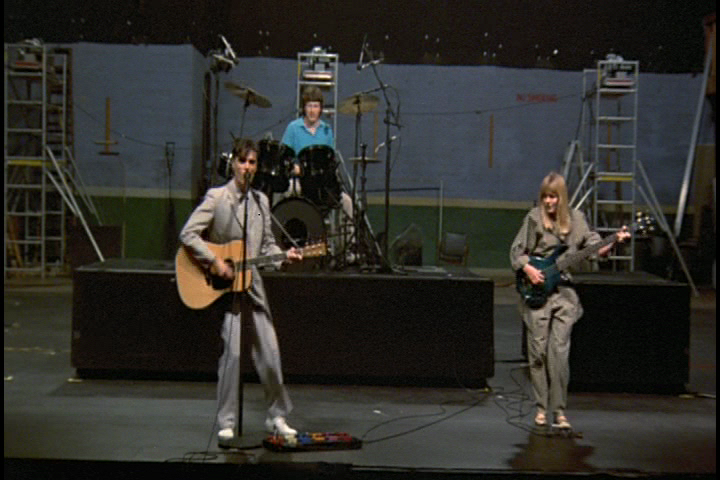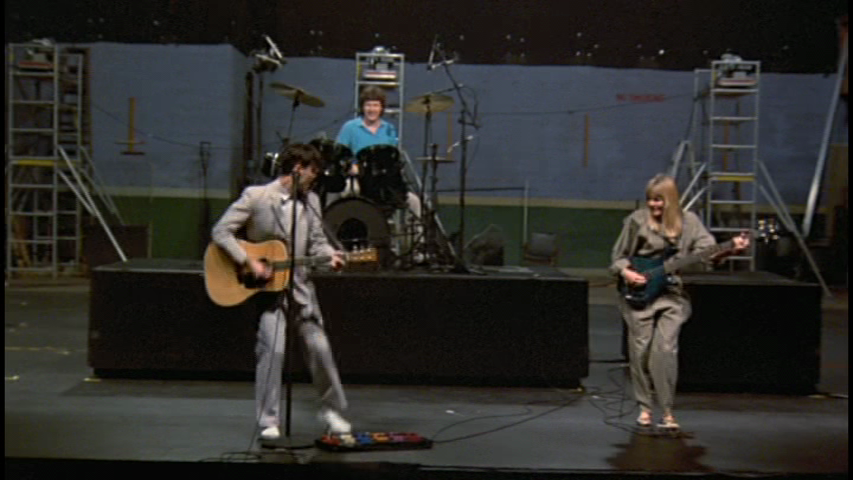My DV camera obviously captures its video in 720x480, and I'm just curious what the thought process was behind this whole idea. That is, why capturing a 4:3 video will end up as 720x480, which is obviously NOT 4:3 and has to be filtered to play correctly (or so it appears to uneducated me).
Try StreamFab Downloader and download from Netflix, Amazon, Youtube! Or Try DVDFab and copy Blu-rays! or rip iTunes movies!
+ Reply to Thread
Results 1 to 30 of 68
Thread
-
-
DV uses non-square pixels, and these are adjusted by your player on playback. NTSC DVD also uses 720 x 480. Just to add to the fun, 16:9 (widescreen) images are also 720 x 480 (NTSC) or 720 x 576 (PAL).
Don't know what filtering you are talking about, unless you mean de-interlacing. In which case it is only required for playback on your PC. Your TV will take care of it for you.
If you want details, try wikipedia. Start your searches with DV video, interlacing, and Aspect RatiosRead my blog here.
-
Yeah, I meant deinterlacing.
Why are non-square pixels used (or why does it end up that way, maybe)? I guess to someone who doesn't understand it, it seems like an unnecessary complication. -
Interlacing is unrelated to resolution.
The choice of 720x480 had to do with early digital video for broadcast. 704 (with the frame padded to 720x480) pixels were deemed necessary to match the horizontal visual resolution of high quality studio analog video. 480 was chosen because it's the nearst mod16 size that can capture all the resolution of the 486 scan lines of NTSC video (6 are cropped away). -
So the "square pixels" thing is only for progressive displays like a PC monitor, whereas interlacing is used to make 720x480 images into coherent 4:3 or 16:9 resolutions?
-
Interlacing is unrelated to pixel aspect ratio.Originally Posted by CursedLemon
Interlacing had to do with reducing bandwidth requirements for analog broadcast. To get smooth motion TV needed 60 pictures per second. But too much bandwidth was required to broadcast 60 full images every second. So they decided to broadcast 60 half pictures every second instead. One half picture (field) scanned all the even scanlines, 1/60th second later the second half pictured scanned all the odd scanlines. By the time the second field is being displayed the first has faded away. That is, you see only one field at a time. This gives the appearance of a full 480 lines of resolution but at the expense of a picture that flickers when there were sharp horizontal edges.
When these half pictures are stored as digital video two halves (fields) are woven together into complete frames. But to properly view the video you need to display one field at a time.
The pixels that make up digital images don't have to be square. When they are square (pixel aspect ratio, PAR = 1:1) the final display aspect ratio (DAR) matches the storage aspect ratio (SAR). The general relationship of DAR, PAR, and SAR is:
DAR = PAR * SAR
So, in general, any frame size can be used to create any display aspect ratio by specifying the shape of individual pixels. -
720x480 are numbers of the stored samples for horizontal and vertical image dimensions, while 4:3 (or 16:9) is an instruction to display picture using those stored samples (often stored as an additional number corresponding to one of the standard AR's). That is why 720x480=345600 and 4:3=1.3333..Originally Posted by CursedLemon
 .
.
Only in a special case ('square pixels') can you directly derive image proportions from pixel numbers (by definition). -
Thanks, guys.
 Stuff like this is so much to wrap your brain around when you only dabble in editing video but every new piece helps build the picture!
Stuff like this is so much to wrap your brain around when you only dabble in editing video but every new piece helps build the picture!
-
The concept of aspect ratios is quite simple:

In the top row a 6 pixel by 4 pixel image drawn with very large square pixels. Its display aspect ratio matches its frame size aspect ratio, 6:4 or 3:2.
The second row the pixels are narrower than they are tall. The resulting display aspect ratio is ~4:3.
In the third row the pixels are wider than they are tall. The resulting display aspect ratio is 16:9. -
So is 720x480 a square-pixel representation of a 480i video?
-
No. Standard definition 480i is 4:3. 720:480 = 3:2. The pixels are 10 percent taller than they are wide (PAR = 10:11). Note that a 720x480 video actually contains the 4:3 image in a 704x480 portion of the frame. There are 8 pixels added to each side for padding. So the full 720 pixel wide frame is slightly wider than 4:3. Using just the 704x480 part:Originally Posted by CursedLemon
DAR = PAR * SAR
4:3 = 10:11 * 704:480
4/3 = (10/11) * (704/480)
4/3 = (10 * 704) / (11 * 480)
4/3 = 7040 / 5280
1.333 = 1.333 -
Haha, wow. I never would've guessed you could figure it mathematically like that. I think I understand now, thanks a bunch.

-
As already mentioned, no. An example of 'square pixel' video: full resolution HD 1920x1080 video (1920/1080=16:9). Some other BD resolutions like 1440x1080 are not 'square pixel' but the video is still stretched to fullscreen which is always 16:9 (no additional number stored).Originally Posted by CursedLemon
In case of NTSC DVD the 704x480 part of the stored 720x480 samples represents a 4:3 (or 16:9) image. Its visible part (unless intentionally cropped to 704 at pre-processing) is 711 horizontally, so on a display without overscan NTSC image is actually not 4:3. Those numbers describe the thing completely. -
DAR = PAR * SAROriginally Posted by Alex_ander
DAR = 1:1 * 1920:1080
DAR = (1/1) * (1920/1080)
DAR = 1 * 1.778
DAR = 1.778 ==> 16:9 widescreen -
A few more details for US domestic digital video.
ATSC SD digital video is 704x480. It can be either 4x3 or 16x9. Neither are square pixel.
ATSC HD 1920x1080 or 1280x720 as transmitted are always 16x9 and square pixel.
The cameras and video recorders used in HD production are often non-square. They are converted to square pixels for transmission. All these formats are 16x9.
HDCAM or HDV are 1440x1080i or 1280x720p.
XDCAM-HD can be 1920x1080p, 1920x1080i, 1440x1080i or 1280x720p
DVCProHD (often used for news/reality) is 1280x1080i or 960x720p.
AVC-Intra is 1920x1080p, 1920x1080i or 1280x720p
HDCAM-SR is 1920x1080p (RGB) or 1920x1080iRecommends: Kiva.org - Loans that change lives.
http://www.kiva.org/about -
Am I correct in saying that PAR is a quality of the display type, not of the video?
-
Not exactly.Originally Posted by CursedLemon
The video is sent with a flagged or implied PAR. The display processor reads the flag or offers user options to scale horizontally. We are talking an HDTV here. Computer monitors are dumb as dirt. They don't read flags or offer aspect options. That is the job of the display card and/or software player software.Recommends: Kiva.org - Loans that change lives.
http://www.kiva.org/about -
Okay, wait.
Earlier in the thread I wanted to know if the 720x480 representation of my recorded 4:3 DV files was due to them being displayed in a 1:1 PAR environment. Am I actually wrong in assuming that? -
"720x480 representation of my recorded 4:3 DV files" ?Originally Posted by CursedLemon
Your DV camera could have been any sensor resolution. If you switched the camcorder to 4:3 DV mode (or it defaulted to 4:3 mode) then the camcorder processor scaled the sensor resolution to 720x480 with implied 0.9091 (NTSC DV) PAR.
720x480 is not square pixel 4x3. If you delete the 16 side pad pixels and multiply 704 by 0.9091 you get 640, or 640x480 square pixel 4x3 for display on a square pixel monitor.
If you switched the cam to 16x9 wide mode, the camcorder processor would have scaled the sensor resolution to 720x480 with implied 1.2121 (NTSC DV wide flag) PAR. If you delete the 16 side pad pixels and multiply 704 by 1.2121 you get ~854, or 854x480 square pixel 16x9 for display on a square pixel monitor.
On second read of your post, it can be interpreted a different way. If 720x480 is displayed with 1.0 square pixel PAR (a lazy player?), then it isn't being displayed 4x3 aspect, it is being horizontally stretched to 3x2 aspect ratio.Recommends: Kiva.org - Loans that change lives.
http://www.kiva.org/about -
Okay, so either way NTSC DV files are recorded as 720x480, and all my camera is doing is changing the PAR, yes? I guess the thing I'm having trouble understanding is how any particular display type deals with showing a video of a different PAR type.
EDIT: Yes, that's kind of what I meant. Sorry. 8( -
Okay, I think I'm kind of looking at video information the wrong way, in that I'm not thinking of pixels as simply "assignments" of data, but rather the data itself, which I assume is incorrect.
-
We have been talking display more than internal camcorder processing. DV video comes with two aspect ratio options. No flag = 4x3. Wide flag tells the player to display 16:9. MPeg2, ATSC SD and DVD work the same way.Originally Posted by CursedLemon
It is the player's job to process the incoming video to 4x3 or 16x9 for that particular display. Most players require you to define your display in preferences as 4x3 or wide. If the display is 4x3 and the video is flagged wide, you get letterbox. If the display is wide and the video is 4x3, you get side pillars.
Camcorder internals are a different story. We can go through that if you want.Recommends: Kiva.org - Loans that change lives.
http://www.kiva.org/about -
Think of a DVD analogy. If you buy the "full screen" DVD version and play it on a wide TV, you get a centered 4x3 picture with side pillars. You can tell the player to "stretch" or fake wide but everybody gets fat.Originally Posted by CursedLemon
Or, you can buy the wide DVD which plays fine on a wide TV but for a 4x3 TV you need to select letterbox or "pan/scan" which chops off part of the wide picture.
Both the "full" and "wide" versions of the DVD are 720x480.Recommends: Kiva.org - Loans that change lives.
http://www.kiva.org/about -
So the PAR is completely independent of the actual video data, correct?
-
Think of it like this: pixels are logical constructs, points that have no physical dimensions. It's when they are displayed on the screen that they take on a physical size and shape. Without any PAR or DAR information most programs assume pixels are square. Since most physical displays have square pixels you end up with a final display aspect ratio that matches the frame size aspect ratio. So a 720x480 video without (or ignoring) PAR/DAR information will be displayed as 720x480 pixels (or some other scaled size that matches that 3:2 aspect ratio like 360x240) on the physical screen.
When PAR information is included the program should scale the image to compensate for the non-square pixels. A 720x480 4:3 DAR video should be displayed as 640x480 (or some other 4:3 frame size) on the screen; or with 16:9 DAR as ~853x480. But many programs do not pay any attention to the PAR/DAR flags and continue to assume square pixels. Editors often show pixels of the source 1:1 with the display so you don't see artifacts generated by digitally scaling to adjust for the PAR/DAR. -
Yeah, that understanding of pixels definitely clears my head about some of this. Thanks a bunch.
-
You may be missing that the video recorded 720x480 by the camcorder is very different when in 4x3 vs 16x9 mode.
In 4x3 mode the video as seen 720x480 square pixel is horizontally stretched.
In 16x9 mode video as seen 720x480 square pixel is horizontally compressed.
Here is an example of "wide" 720x480 (horizontally compressed).

Here is the same picture horizontally stretched to 16x9.
 Recommends: Kiva.org - Loans that change lives.
Recommends: Kiva.org - Loans that change lives.
http://www.kiva.org/about -
A full size example
720x480 (DV wide) horizontally squeezed

854x480 (16x9) square pixel
 Recommends: Kiva.org - Loans that change lives.
Recommends: Kiva.org - Loans that change lives.
http://www.kiva.org/about
Similar Threads
-
Is there such a thing as "DVD-RW 4X Double Layer 8.5G"???????
By will7370 in forum MediaReplies: 2Last Post: 3rd Jun 2009, 17:04 -
"Any Video Converter" output format choices - can anyone explain?
By slipkid in forum Video ConversionReplies: 5Last Post: 14th Feb 2009, 17:09 -
Please explain "Progressive Scan DVD menus"
By schematic2 in forum Authoring (DVD)Replies: 1Last Post: 2nd Oct 2008, 19:25 -
Is there really such a thing as "standard mpeg 4 video"?
By yoda313 in forum Portable VideoReplies: 5Last Post: 25th May 2008, 12:16 -
DvdAuthorGUI - can somebody explain "loop menu"?
By dphirschler in forum Authoring (DVD)Replies: 8Last Post: 25th Sep 2007, 15:03




 Quote
Quote